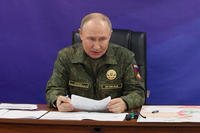Joseph V. Micallef is a best-selling military history and world affairs author, and keynote speaker. Follow him on Twitter @JosephVMicallef.
In 1972, President Richard Nixon made an official visit to the People's Republic of China. The visit, several years in the planning, marked the resumption of direct diplomatic contacts between China and the U.S. after almost a quarter century of political isolation.
The thaw culminated in 1979 when the U.S. established full diplomatic relations with China.
Nixon's visit was motivated by a desire to gain more leverage in U.S. relations with the Soviet Union and to secure Beijing's assistance in negotiating a peace agreement between North Vietnam and South Vietnam. The trip also came against a backdrop of rising Soviet power around the world, especially the dramatic growth of the Soviet blue water navy and Moscow's wide-ranging support for subversive movements around the world.
The overture to China also came at a time when Soviet-Chinese relations were deteriorating. The condition was underscored by repeated military clashes between China and the USSR, along the Ussuri River frontier between the two countries, in 1969. There were widespread rumors at the time that Moscow had considered a nuclear strike against the Chinese nuclear testing facilities in Xinjiang. Amidst a rapid buildup of Soviet military forces along the Sino-Soviet frontier, Chinese leaders concluded that the USSR posed a greater threat to China than did the U.S.
Nixon's dramatic détente with the Chinese was described at the time as "playing the China card," a term that has now been enshrined in history books.
Fast-forward a half century later. China and the U.S. have now become each other's principal adversaries. They are engaged in a wide-ranging military, economic, technological and diplomatic competition around the world.
Russia, the successor state to the Soviet Union, no longer commands the global superpower status once enjoyed by the USSR. With an economy smaller than that of Texas and heavily reliant on the export of raw materials, primarily oil and gas, it has little prospect of regaining that status.
Moscow, however, still commands a considerable army, can project significant military power along its periphery, and retains a large intercontinental-range nuclear arsenal and an extensive military-industrial-technological complex.
Now that Russia is the weakest country in the U.S.-China-Russia triumvirate, will Russian President Vladimir Putin try to play his own "China card" to find leverage against the U.S.?
Russia and China
Over the last decade, Moscow has significantly expanded its economic relations with China, which is now the world's largest importer of oil and gas. It generally ranks in the top three global importers of most commodities. As one of the world's largest exporters of hydrocarbons, it makes sense for Russia to seek new markets in China, especially since its ability to expand its energy exports to the European Union (EU) have been hobbled by U.S. and European sanctions imposed on Moscow following its 2014 seizure of Crimea.
Those sanctions also closed access to capital from Western financial institutions, so Moscow has increasingly looked to Beijing for financing of its energy and other resource development projects. Chinese capital, for example, has figured prominently in the financing of the Yamal LNG project, and will play a major role in underwriting Gazprom's $55 billion Power of Siberia gas pipeline. This project will develop the Chayanda and Kovykta gas fields in Yakutia and construct a pipeline to carry gas to Heihe in Heilongjiang, where it will connect with the existing Heihe-Shanghai pipeline.
Beijing has incorporated Russia's Northeast Passage maritime route across Russia's various Arctic seas into its broader Belt and Road Initiative (BRI) infrastructure development program, designating it the "Polar Silk Route."
Moscow has also played a role in the modernization of China's armed forces. Historically, China has been one of Russia's largest arms customers, second only to India. In 2018, China accounted for around 14% of Moscow's arms exports, amounting to roughly $15 billion.
Russia has supplied China with the Su-35 multi-role fighter. The Su-35 carries both guided and unguided air-to-air and air-to-ground missiles, as well as both conventional and smart bombs. The two countries are also working jointly to develop a heavy-lift helicopter for military use.
And the Kremlin is providing China with six S-400 long-range air defense systems. This is the same system that was recently purchased by Turkey. The Russian systems will add to China's existing air defense network. Deployment of the S-400 could enable China to create a no-fly zone over the Taiwan Strait.
Russia is also helping China build an early warning system to identify intercontinental ballistic missile launches. Currently, only the U.S. and Russia have this capability.
Russia and China have also been expanding the scope of their joint military exercises. Prior to 2018, these joint exercises revolved around counter-terrorism scenarios. Starting with the Vostok-2018 exercise, the joint exercises now emphasize joint defensive and counterattack training and coordination.
Playing the China Card
Putin has not been shy about dropping hints that he would consider a more formal alliance with China. On Oct. 20, at the most recent meeting of the Valdai Discussion Club, Putin, when asked about a potential military alliance with the PRC, replied, "It is possible to imagine anything. We have not set that goal for ourselves. But in principle, we are not going to rule it out either."
The Valdai Discussion Club is a Moscow-based think tank and discussion forum, established in 2004. It has often been used as a venue to signal changes in Russian policy or to launch trial balloons.
On the other hand, notwithstanding the advantages of greater Sino-Russian cooperation, long-term Russian and Chinese interests diverge significantly.
While China has accommodated Russia within its BRI, the program runs counter to Russia's long-term interests. The BRI, if successful, will draw the former Soviet states of central Asia, the so called "stans" (Uzbekistan, Tajikistan, Kazakhstan, Turkmenistan, Kyrgyzstan and Azerbaijan), into China's economic orbit and presumably into its political and diplomatic one also.
Moscow had intended to reintegrate these former Soviet Republics into its Eurasian Economic Union, a customs union and common market, and to leverage its geographic access to European energy markets to obtain transit fees and political advantage on the export of Central Asia's energy resources to Europe. If those energy exports go east to China, however, Moscow will have a lot less leverage over the "stans," even if in the short term it can offer access to existing Russian pipeline and railroad infrastructure. Long term, however, those countries will find themselves competing directly with Russia to export hydrocarbons to China.
Although the 1991 Sino-Soviet Border Agreement ostensibly settled the border dispute between the two countries, Chinese historians, with Beijing's tacit approval, have continued to criticize the "unequal treaties" signed between the Russian Empire and the Ching Dynasty in the 19th century, arguing that the disputed territory should be returned to China. The Treaty of Aigun (1858) and the Treaty of Beijing (1860) transferred roughly 600,000 square miles of Chinese territory in Manchuria and western China to Russian control.
At the 18th and 19th Chinese Communist Party Congresses, Chinese President Xi Jinping, for example, called for "recovery of sovereignty over Chinese territories lost through the imposition of unequal treaties by hostile foreign powers."
Moreover, there are presently millions of Chinese immigrants, both legal and illegal, in the Russian Far East. Moscow has turned a blind eye to the Chinese migration, in part because the region suffers from chronic labor shortage, and also because much of the legal immigration is tied to Chinese investments in the Russian Far East.
Russian inhabitants of the region have argued that the illegal migration constitutes a de facto Chinese invasion and have expressed concern that Beijing intends to take back its historic territory and possibly more. These concerns were underscored in a 2015 film by local film makers, "China -- A Deadly Friend," which became an internet sensation in Russia and was widely viewed.
It's not clear, however, what China gains from a formal alliance, military or otherwise, with Russia. Less than 2% of China's trade is with Russia, compared to around 20% with the U.S. Closer relations with Russia won't move that needle in any significant way. As long as the U.S. and the EU continue to impose sanctions on Russian energy companies, China's energy demand and investment capital will continue to give it the upper hand in dealing with Moscow.
A military alliance between the two countries would also represent a significant liability for China, tying it to a declining power that might draw Beijing into conflicts it would rather avoid.
The possibility of a Russian-China alliance poses significant challenges to the U.S., especially to its military posture in East Asia and the Western Pacific. It's not surprising that the Kremlin would use that threat to obtain more leverage against the U.S. Nor is Russia alone in this regard. Beijing may find it just as useful to play the "Russia card" to expand its leverage against the U.S.
While Russian and Chinese interests diverge significantly in the long term and, in many instances, are inimical to each other, both countries will use an expansion of military and economic cooperation in the short term to seek more leverage against the U.S., in part to minimize the impact of American sanctions against either country.
Moreover, even if their cooperation stops far short of a military alliance, a continued expansion of Sino-Russian military ties and strategic coordination is problematic for the U.S. Chinese naval access to Russian Pacific ports such as Vladivostok, for example, would represent a significant challenge to U.S. naval dominance in the western Pacific.
Likewise, the possibility that Beijing might coordinate a move on Taiwan with a comparable Russian move against the Baltic states, although highly unlikely, can't be ruled out either.
Even more important is the related question of whether the U.S. should seek to normalize its relations with Moscow so it could potentially play its "Russia card" in its negotiations with Beijing.
In the end, neither Russia or China may opt to seek a formal military alliance. Simply dropping hints of a potential one may suffice to seek leverage. Even if Putin was willing to play his China card it's not clear that Beijing would be willing to accommodate him.
Regardless of what either country ultimately does, however, this card game is just getting started.
-- The opinions expressed in this op-ed are those of the author and do not necessarily reflect the views of Military.com. Find more information on how to submit your own commentary.















